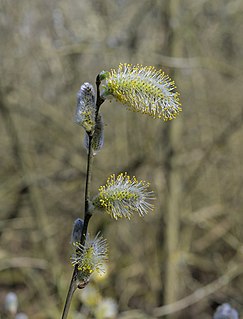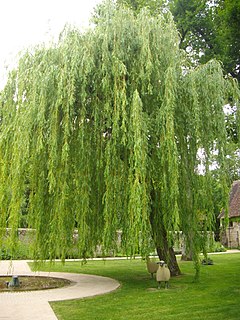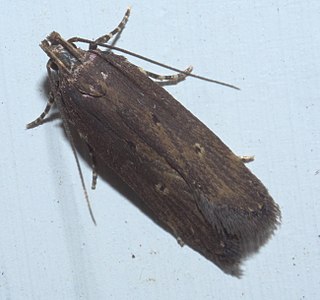Related Research Articles

Willows, also called sallows and osiers, from the genus Salix, are around 400 species of deciduous trees and shrubs, found primarily on moist soils in cold and temperate regions of the Northern Hemisphere.

Salix alba, the white willow, is a species of willow native to Europe and western and central Asia. The name derives from the white tone to the undersides of the leaves.

Salix caprea, known as goat willow, pussy willow or great sallow, is a common species of willow native to Europe and western and central Asia.

Salix purpurea, the purple willowpurpleosier willow or purple osier, is a species of willow native to most of Europe and western Asia north to the British Isles, Poland, and the Baltic States.

Salix × fragilis, with the common names crack willow and brittle willow, is a hybrid species of willow native to Europe and Western Asia. It is native to riparian habitats, usually found growing beside rivers and streams, and in marshes and water meadow channels. It is a hybrid between Salix euxina and Salix alba, and is very variable, with forms linking both parents.

Salix viminalis, the basket willow, common osier or osier, is a species of willow native to Europe, Western Asia, and the Himalayas.

A catkin or ament is a slim, cylindrical flower cluster, with inconspicuous or no petals, usually wind-pollinated (anemophilous) but sometimes insect-pollinated. They contain many, usually unisexual flowers, arranged closely along a central stem that is often drooping. They are found in many plant families, including Betulaceae, Fagaceae, Moraceae, and Salicaceae.

Salix babylonica is a species of willow native to dry areas of northern China, but cultivated for millennia elsewhere in Asia, being traded along the Silk Road to southwest Asia and Europe.

Salix nigra, the black willow, is a species of willow native to eastern North America, from New Brunswick and southern Ontario west to Minnesota, and south to northern Florida and Texas.

Chionodes is a genus of moths of the family Gelechiidae. It is distributed throughout much of the world. The larvae of many species use the Douglas fir as a host plant.

Salix lasiolepis is a species of willow native to western North America.

A withy or withe is a strong flexible willow stem, typically used in thatching and for gardening.
Chionodes petalumensis is a species of moth in the family Gelechiidae. It is found in North America from southern British Columbia to California, Arizona and Colorado.

Salix triandra, with the common names almond willow, almond-leaved willow or black maul willow, is a species of willow native to Europe and Western and Central Asia. It is found from south-eastern England east to Lake Baikal, and south to Spain and the Mediterranean east to the Caucasus, and the Alborz Mountains. It usually grows in riparian habitats, on river and stream banks, and in wetlands.

Salix aurita, the eared willow, is a species of willow distributed over much of Europe, and occasionally cultivated. It is a shrub to 2.5 m in height, distinguished from the similar but slightly larger Salix cinerea by its reddish petioles and young twigs. It was named for its persistent kidney-shaped stipules along the shoots.
Nomen illegitimum is a technical term, used mainly in botany. It is usually abbreviated as nom. illeg. Although the International Code of Nomenclature for algae, fungi, and plants uses Latin terms for other kinds of name, the glossary defines the English phrase "illegitimate name" rather than the Latin equivalent. However, the Latin abbreviation is widely used by botanists and mycologists.

Salix OS is a multi-purpose Linux distribution based on Slackware.

Crofelemer is a botanical drug for the treatment of diarrhea associated with anti-HIV drugs such as nucleoside analog reverse transcriptase inhibitors and protease inhibitors. Other possible uses include diarrhea in children, acute infectious diarrhea, and diarrhea in patients with irritable bowel syndrome. It is a purified oligomeric proanthocyanidin from "dragon's blood", the sap of the South American tree Croton lechleri.

Chionodes discoocellella, the eyeringed chionodes moth, is a moth in the family Gelechiidae. It is found in the United States, where it has been recorded from Maine to South Dakota, Florida, Texas and Colorado.
Chionodes salicella is a moth in the family Gelechiidae. It is found in North America, where it has been recorded from British Columbia to California and in Montana.
References
- ↑ Beccaloni, George; et al., eds. (February 2005). "Scientific name search". The Global Lepidoptera Names Index. Natural History Museum, London. Retrieved 2015-06-03.
- ↑ Chionodes at funet
- ↑ mothphotographersgroup